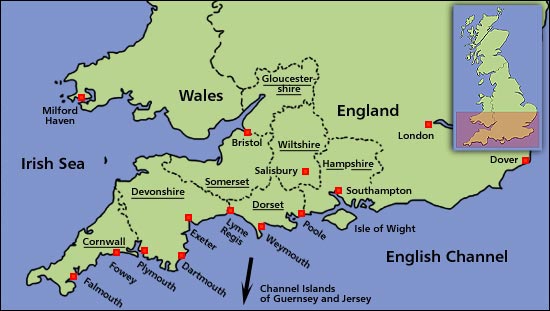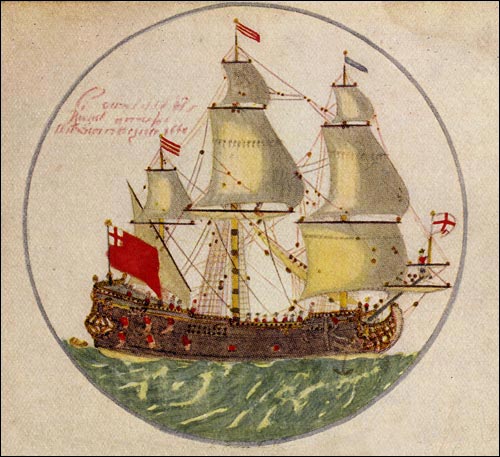The English Migratory Fishery and Trade in the 17th Century
The basic characteristics of the migratory fishery did not change very much in the 300 years of its existence. The technology, the patterns of activity, and the fundamental skills all had a certain timeless quality about them. But this does not mean that the migratory fishery itself did not change. Like everything else, it was affected by the political, economic, and social developments occurring in the western world.
By the opening years of the 17th century, France and England were the foremost participants in the Newfoundland fishery. The century was anything but tranquil; pirates and corsairs, civil and international wars, colonization and settlement, political centralization, poor fisheries, competition for control of the fishery and its development, all created hazards and difficulties for the fishing industry. Survival required effective responses, which often caused the fishery itself to change. Some participants disappeared, while others faded into secondary importance. A very small number not only survived, but eventually came to dominate the fishing industry and trade in the 18th century.
The English West Country Fishery
At the start of the 17th century, the British cod-fishing industry was centred in the south-western "toe" of England known as the "West Country." In addition, the Channel Islands of Guernsey and Jersey participated regularly. Between 1615 and 1640, 70% of the English vessels that sailed to fish at Newfoundland came from the West Country, a region which had the location, the capital, and the men to assume the leadership in the British fishery at Newfoundland.
Five counties made up the West Country: Dorset, Devonshire, Somerset, Hampshire, and Cornwall. Although the last two soon dropped out of direct involvement in the Newfoundland fishery, both continued to be a source of labour. Since the county of Somerset was involved in a variety of other activities, the fishery became strongly identified with Dorset and Devonshire.

©1998, Newfoundland and Labrador Heritage Web Site
The West Country had an important and flourishing wool and cloth trade in addition to the fishery. But in England as in the rest of Europe, the fishery was thought to be of great economic importance because of the supplementary employment it provided by stimulating dozens of auxiliary trades. In his Discourse and Discovery of the Newfoundland (1620), Richard Whitbourne described some of the products consumed by the fishery: nets, hooks, leads, lines, rope, bread, and beer. Bakers, brewers, coopers, chandlers, net-makers, tackle-makers, smiths, hook-makers, carpenters, and rope-makers were among the many tradesmen who never left their West Country homes, yet were employed by the fishery just as surely as a splitter or a beach master in Renews.
The West Country Merchant-Venturers: Facing the Risks
The Newfoundland trade was controlled by a small number of West Country merchant-venturers, who often referred to themselves as the "Western Adventurers." They had common interests and concerns, were often related by marriage, and accumulated considerable wealth. This power and cohesiveness made them very influential within the West Country. At the same time, because the Newfoundland trade was highly competitive rivalries between individual merchants, merchant families, or entire merchant communities could be fierce. Religious and political differences further divided them. This happened frequently during the 17th century, and it is an indication of how troubled the Newfoundland trade was during that period.
The first 20 years after 1600 experienced rapid expansion in the fishery. By 1620, possibly as many as 300 English ships and vessels annually sailed to Newfoundland, with some West Country ports each sending as many as 80 vessels. Many factors account for this growth: the end of the war with Spain in 1603, the elimination of the Spanish fishery at Newfoundland, bountiful fish stocks, and an availability of surplus capital. But a succession of hardships following 1620 caused the fishery to shrink and forced some West Country ports quit the fishery altogether.
Pirates
Until about 1640 the fish trade was plagued by marauding Barbary pirates known as the Sallee rovers. They were renegade seamen from all nations who sailed out of bases in North Africa. Piracy itself was nothing new to the Newfoundland fishery; the notorious Peter Easton and Henry Mainwaring were only two among the many who had raided Newfoundland harbours during the 1610s. Because it was dispersed and seasonal, the fishery could endure piracy of this sort. since while some harbours suffered, others were left untouched.
The trade was different. The value of the cargoes carried by fishing ships when they left in the spring, or by sack ships approaching market destinations in the fall, was enormous. If one of these was lost, the impact on the merchant-venturer was significant.

It was the trade which was the usual target of the Sallee rovers, who cruised the coasts of Portugal and Spain while waiting to intercept merchantmen who converged in the market ports. They even sailed into the English Channel because neither France nor England possessed navies capable of effectively challenging them. The losses in shipping and men were staggering. In the four years from 1624 to 1628, the town of Poole alone claimed to have lost 20 ships - a figure equal to the number of ships the town had once sent out annually. Thereafter, Poole was only able to send three ships to Newfoundland.
Wars
Adding to West Country difficulties were the frequent wars between England and various European countries after 1620. Fishermen were "pressed" into the navy, shipping became a target of enemy attacks, and markets in hostile countries were closed to English fish. Even the mere possibility of war could be disruptive. For example, in 1623 the threat of a war with Spain caused the English government to place an embargo on fish exports to that country. The English civil war (after 1640) and conflicts with Spain and Holland during the 1650s disrupted the fishery and trade so deeply that the number of ships in the fishing fleet had decreased from 300 to barely one hundred by 1660. Only 43 ships sailed for Newfoundland by the year 1684.
Many West Country ports simply abandoned the fishery altogether: The Cornish ports of Falmouth and Fowey, as well as ports such as Lyme Regis, Weymouth, Southampton, even Plymouth (one of the most important participants at the beginning of the century) all gave up. The worst years came after 1690 when yet another war, this time with France, caused the English government to prohibit all fishing ships from sailing to Newfoundland. This was a matter of necessity: fishermen were needed to man the navy and as a result, the migratory fishery did not resume until 1693.
Aside from the hazards of piracy and war were all the usual risks associated with a speculative and unpredictable industry and trade. Ships disasters, fraud, poor fish catches and congested markets were all possibilities. The life of a merchant-venturer was insecure because he might easily prosper in the fishery, only to lose his fortune in other activities. As a result, merchant-venturers, suspicious of new situations, often adopted a pessimistic outlook. Their frequent predictions of doom and collapse, cries of ruin, lamentations, and complaints of meager profits dwarfed by mountainous costs should all be viewed with some scepticism. Nevertheless, it is true that by the end of the 17th century the English migratory fishery had really been on the brink of collapse. One indication of this is the disappearance of the names of many merchant-venturers who had previously been active in the fishery and trade.




